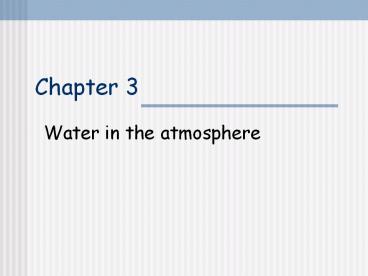Water in the atmosphere - PowerPoint PPT Presentation
Title: Water in the atmosphere
1
Chapter 3
- Water in the atmosphere
2
3.1 Introduction
- Water only 0 to 4 by volume
- No water ? no rainbow
- No water ? no thunderstorm
- No water ? no life
3
3.2 Humidity and saturation
- 3 quantities to measure humidity
- Absolute humidity
- Mixing ratio
- Relative humidity (discuss this only)
- We shall discuss
- Saturation
- Relative humidity
- Dew point
4
3.2 Saturation and humidity
Saturation
At first, evaporation rate is faster than
condensation rate
5
3.2 Saturation and humidity
Finally it is saturated evaporation rate same as
condensation rate
Saturation pressure increases for higher
temperature
6
3.2 Saturation and humidity
- Higher temperature ? saturated vapour pressure
higher ?water content in air higher also
7
3.2 Saturation and humidity
Relative humidity
The ratio of the actual water content in the air
to the water content in saturated air at the same
temperature
8
3.2 Saturation and humidity
Relative humidity
Questions? Higher relative humidity means higher
water content?
9
3.2 Saturation and humidity
Relative humidity
10
3.2 Saturation and humidity
Dew point
- Dew point is the temperature required to cool a
parcel of air to reach saturation - dew point of the flask of air is 10?C
11
3.3 Atmospheric stability
Adiabatic temperature change
at higher altitude, atmospheric pressure lower,
the parcel of air is expanded and causes lower
its temperature.
temperature of the environment is lower at higher
altitude also.
12
3.3 Atmospheric stability
- If rising parcel cooler than its surrounding ?
sink ?becomes stable - If rising parcel hotter than its surrounding ?
continue to rise ? becomes unstable.
13
3.3 Atmospheric stability
Dry adiabatic rate, wet adiabatic rate, and
lifting condensation level
14
3.3 Atmospheric stability
- As water vapor condenses ? energy released
(called latent heat) ? air heated gently, so wet
adiabatic rate is smaller than dry adiabatic
rate. - wet adiabatic rate
- 5?C per 1 km (high moisture content) to 9?C per
1 km (low moisture content).
15
3.3 Atmospheric stability
Environmental lapse rate and stability
- Stability of air depends on adiabatic rate
environmental lapse rate - Adiabatic rate characteristic of parcel
- Environmental lapse rate temperature of
environment at various altitudes about 5?C per 1
km
16
3.3 Atmospheric stability
(a) Absolute stability
17
3.3 Atmospheric stability
(b) Absolute instability
18
3.3 Atmospheric stability
(c) Conditional instability
19
3.3 Atmospheric stability
Examples in daily life
Why is the air more polluted at night?
20
3.3 Atmospheric stability
Examples in daily life
1. Temperature inversion
- Usually occurs at night, if temperature increases
with altitude, the so environment lapse rate is
negative. - Hence, it is smaller than both wet and dry
adiabatic rates. - Result absolute stable air! The air is trapped!
21
3.3 Atmospheric stability
Examples in daily life
22
3.3 Atmospheric stability
Examples in daily life
23
One evening in Hong Kong
24
3.3 Atmospheric stability
Examples in daily life
Why are there mid-afternoon rain showers in
summer?
25
3.3 Atmospheric stability
Examples in daily life
2. Mid-afternoon rain showers in summer
- Some place is hotter, e.g. Million Road
- Air above lighter than surroundings
- Air rises
- Water condenses at lifting condensation level
- Clouds form ? shower
26
3.4 Orographic lifting and rainshadow deserts
Formation of a desert on the leeward side of a
mountain. Why?
27
Cloud formation
Cloud seeding
- A kind of weather modification
- Spread silver iodide
- Supercooled droplet condenses on silver iodide
- Big water drops form
- Raining
28
Cloud Forming Apparatus
Cloud seeding
29
Supercooled liquid
- Must pure water be in the form of ice below 0?C?
- Answer NO! ? Supercooled water
- Touch solid surface ? condense, heat released
30
Example of supercooled liquid Heat pack
- A pack of colored liquid with a metal button
inside. - If the button is bent and release.
- The liquid condenses and releases heat.
31
Example of superheating
?????????????
superheating.mpg
32
(No Transcript)
33
Toy drinking bird































